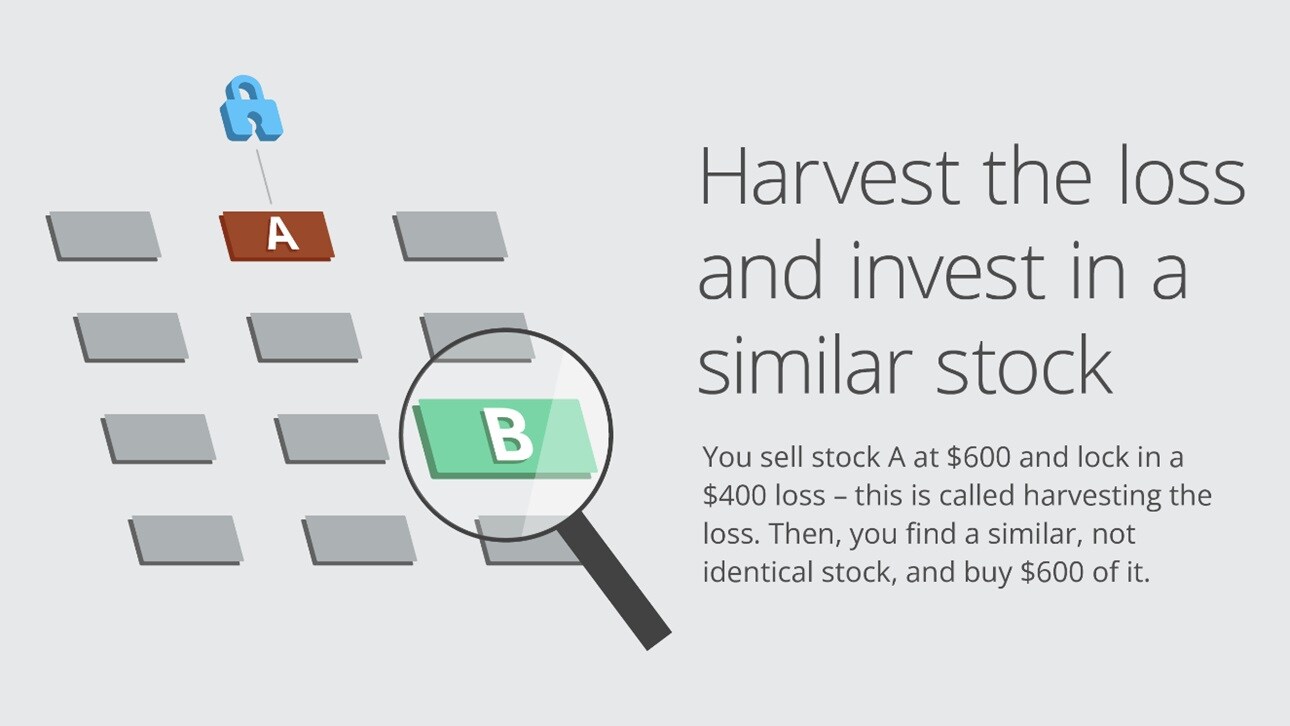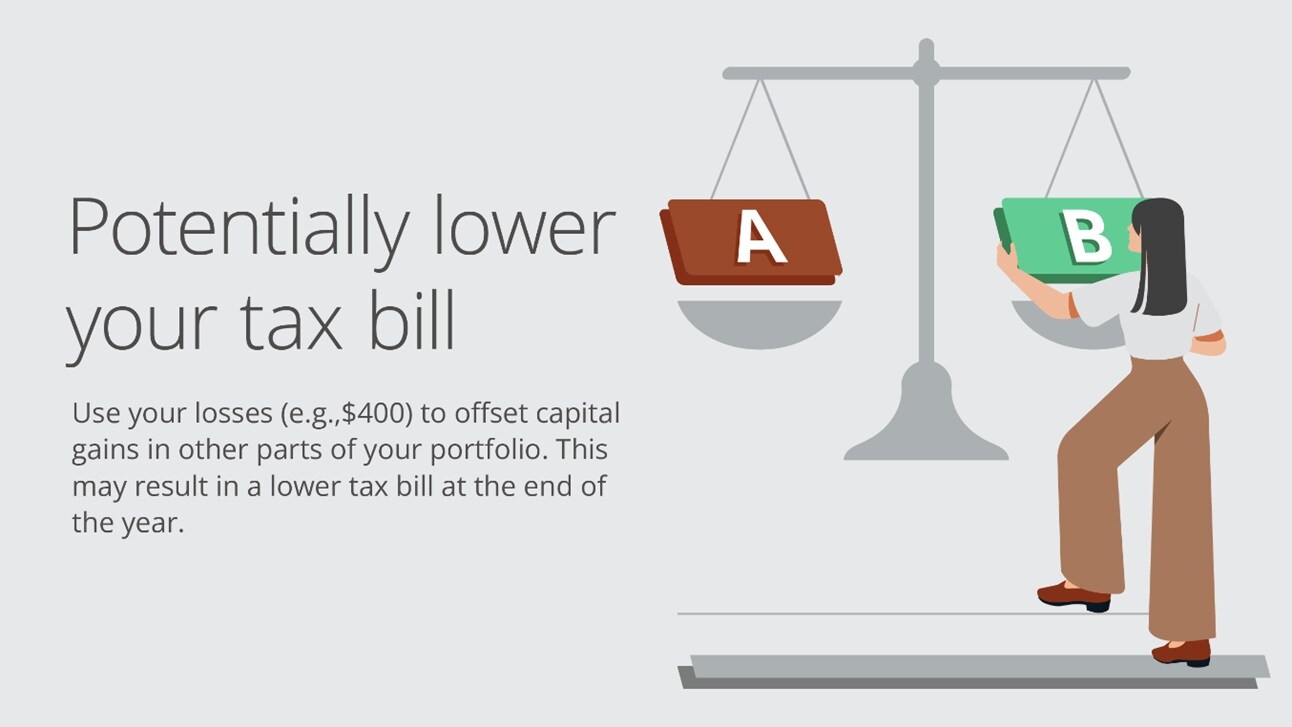Tax & regulations How tax loss harvesting can help in uncertain markets
- If you sell investments at a loss you may be able to use them to offset gains to reduce your tax bill.
- Be mindful not to sell and then reacquire a “substantially identical” position too quickly, as this could constitute a “wash sale” and the tax rules may defer or disallow the loss.
- If you want to continue to have exposure to the industry of the stock that you’ve sold, you may want to buy a similar but sufficiently different investment, as will be discussed later in the article.
- Speak with your tax professional before making any moves.

If investments in your portfolio have lost money due to recent volatility in the markets, you may want to consider tax-loss harvesting. This is a strategy that involves selling investments that have a loss in order to offset gains on other investments.
The idea is that you take the money from the sale of the investment at a loss and invest it elsewhere – either in a new industry or in a similar, but not identical, investment to continue having exposure to the same industry. However, in order to deduct a loss from the sale of stock or securities, you must not trigger the wash sale rule, discussed below.
Typically, an individual with more capital losses than gains in a tax year can also use up to $3,000 of capital losses to offset ordinary income. This means you could potentially reduce your taxable income and as a result the amount you owe in taxes.
How tax loss harvesting works
Get up to $700
When you open a J.P. Morgan Self-Directed Investing account, you get a trading experience that puts you in control and up to $700 in cash bonus.
Watch out for wash sales
If you sell a stock or security and buy the same stock or security again within 30 days before or after the sale, that’s generally known as a “wash sale.” This type of transaction will disqualify your loss on the investment you sold, so you can’t use it that year to offset gains. Note that it doesn’t have to be the exact same investment; purchasing another stock or security that is “substantially identical” to the stock or security you sold can trigger the wash sale rule. If you’re not sure whether a stock or security is substantially identical, check with your accountant or other tax professional. If you buy the same stock or security or a “substantially identical” one that’s too similar to the one you sold and trigger the wash sale rule, the loss you incurred on the sale generally will be added to the tax basis the replacement investment, deferring the loss from the stock you originally sold until you ultimately sell the replacement investment.
What else falls into the category of “substantially identical” when selling a stock, for example? A call option typically would, or a number of other investments that are similar enough to the sold stock that the IRS considers it to be substantially identical. Exchange-traded funds (ETFs) that track the same index as another ETF and different bonds of the same issuer may also be considered substantially identical. You must consider all the facts and circumstances in your particular case.
Tips to stay in the market and avoid triggering a wash sale
There are two ways to maintain your position in an investment that you want to sell for a loss without triggering a wash sale.
- “Double up” on it more than 30 days before you intend to sell it, or you can wait for at least 30 days after you sell to repurchase it. Since doubling up heightens your exposure to the investment for the period before you sell it, you need to be sure that the increased concentration is appropriate for you.
- Consider purchasing a substitute investment that is not substantially identical. The IRS states that “in determining whether stock or securities are substantially identical, you must consider all the facts and circumstances in your particular case."1 It also adds that “ordinarily, stocks or securities of one corporation are not considered substantially identical to stocks or securities of another corporation.”2 As such, common substitutes for single stock positions are stocks that trade similarly, such as two beverage companies that are direct competitors, or market proxies like ETFs that track the broader market.
Note: If any of the replacement investments appreciate in value and you sell them before you have held them for over a year, any gain will be short-term and taxed at ordinary income rates.
Everyone has a different financial and tax situation, so be sure to speak with your financial advisor and/or tax professional before engaging in a tax loss strategy.
If you want to explore investing yourself, consider checking out J.P. Morgan Online Investing. If you would prefer to work with a J.P. Morgan advisor, reach out or stop into one of our Chase branches.
Invest your way
Not working with us yet? Find a J.P. Morgan Advisor or explore ways to invest online.
Megan Werner
Editorial staff, J.P. Morgan Wealth Management
Editorial staff, J.P. Morgan Wealth Management
Megan Werner is a member of the J.P. Morgan Wealth Management (JPMWM) editorial staff. Prior to joining the JPMWM team, she held various freelance, contract and agency positions as a content writer across a range of industries. In additi ...More
Footnotes
-
1
Internal Revenue Service, “2023 Instructions for Schedule D (2023).”
-
2
Ibid.






